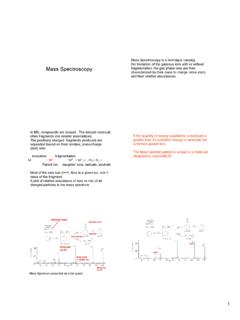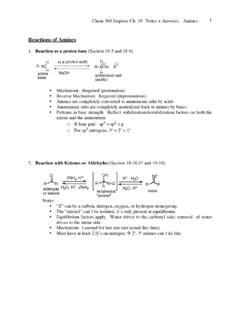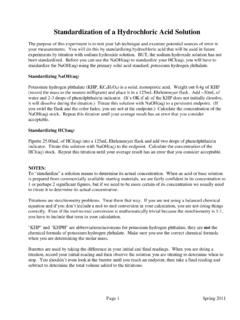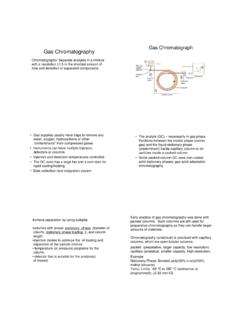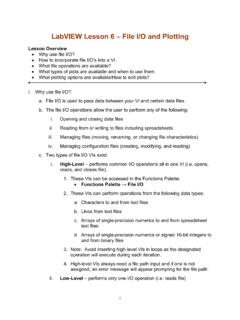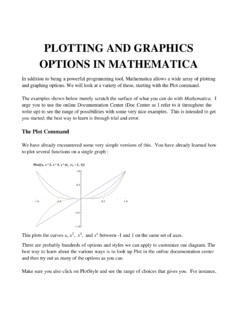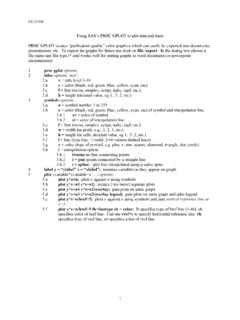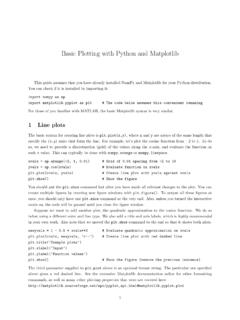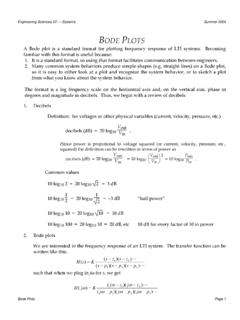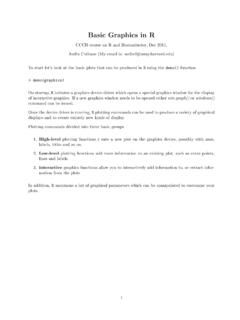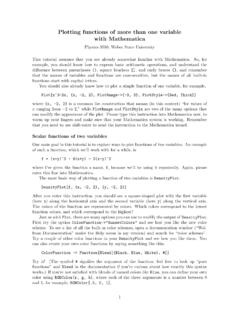Transcription of 9. Analysis of an Acid-Base Titration Curve: The Gran Plot
1 9. Analysis of an Acid-Base Titration Curve: The gran plot Quantitative Chemical Analysis 9. Analysis of an Acid-Base Titration Curve: The gran plot In this experiment, you will titrate a sample of pure potassium hydrogen phthalate (Table 10-4) with standard NaOH. A gran plot will be used to find the equivalence point and Ka. Activity coefficients are used in the calculations of this experiment. Green Profile Using a gran plot to Find the End Point of a Titration See Section 0. A problem with using derivatives to find the end point of a Titration is that Titration data are least accurate right near the end point because buffering is minimal and electrode response is sluggish.
2 A gran plot uses data from before the end point (typically from Ve or Ve up to Ve) to locate the end point. Consider the Titration of a weak acid, HA: [H+] H+[A-] A- HA H+ + A- Ka = [HA] HA (1). It will be necessary to include activity coefficients in this discussion because a pH electrode responds to hydrogen ion activity, not concentration. At any point between the initial point and the end point of the Titration , it is usually a good approximation to say that each mole of NaOH converts 1 mol of HA into 1 mol of A-. If we have titrated Va mL of HA (whose formal concentration is Fa) with Vb mL of NaOH (whose formal concentration is Fb), we can write moles of OH- delivered VbFb [A-] = total volume = Vb + Va original moles of HA moles of OH- VaFa VbFb [HA] = total volume = Va + Vb Substitution of these values of [A-] and [HA] into the equilibrium constant gives [H+] H+VbFb A- Ka = (V F V F ).
3 A a b b HA. 42. 9. Analysis of an Acid-Base Titration Curve: The gran plot Quantitative Chemical Analysis which can be rearranged to HA VaFa VbFb . Vb[H+]JH+ = - Ka Fb (2). A .. 10-pH. The term on the left is Vb . 10-pH, because [H+]JH+ = 10-pH. The term in parentheses on the right is VaFa VbFb VaFa Fb = Fb Vb = Ve Vb Equation 2 can, therefore, be written in the form JHA. gran plot equation: Vb . 10-pH = Ka (Ve Vb) (3). JA- A graph of Vb . 10-pH versus Vb is called a gran plot . If JHA/JA- is constant, the graph is a straight line with a slope of KaJHA/JA- and an x-intercept of Ve.
4 Figure 1 shows a gran plot for the Titration in Figure 10-5 of the textbook. Any units can be used for Vb, but the same units should be used on both axes. In Figure 1, Vb is expressed in microliters on both axes. Figure 1. gran plot for the first equivalence point of Figure 10-5 of the textbook. The last 10 20% of volume prior to Ve is normally used for a gran plot . 43. 9. Analysis of an Acid-Base Titration Curve: The gran plot Quantitative Chemical Analysis The beauty of a gran plot is that it enables us to use data taken before the end point to find the end point.
5 The slope of the gran plot enables us to find Ka. Although we derived the Gran function for a monoprotic acid, the same plot (Vb . 10-pH versus Vb) applies to polyprotic acids (such as H6A in Figure 10-5 of the textbook). The Gran function, Vb . 10-pH, does not actually go to 0, because 10-pH is never 0. The curve must be extrapolated to find Ve. The reason the function does not reach 0 is that we have used the approximation that every mole of OH- generates 1 mol of A-, which is not true as Vb approaches Ve. Only the linear portion of the gran plot is used.
6 Another source of curvature in the gran plot is changing ionic strength, which causes JHA/JA- to vary. In Figure 10-5 of the textbook, this variation was avoided by maintaining nearly constant ionic strength with NaNO3. Even without added salt, the last 10 20% of data before Ve gives a fairly straight line because the quotient JHA/JA- does not change very much. The gran plot in the acidic region gives accurate results even if there is CO2 dissolved in the strong base titrant. The gran plot in the basic region can be used to measure CO2 in the strong base.
7 For completeness, we note that if weak base, B, is titrated with a strong acid, the Gran function is 1 JB . Va . 10+pH = K . (Ve Va) (4). a JBH+ . where Va is the volume of strong acid and Ka is the acid dissociation constant of BH+. A graph of Va . 10+pH versus Va should be a straight line with a slope of JB / (JBH+Ka) and an x-intercept of Ve. Procedure (An Easy Matter). 1. Dry about g of potassium hydrogen phthalate at 105 C for 1 h and cool it in a desiccator for 20 min. Accurately weigh out ~ g and dissolve it in water in a 250-mL volumetric flask.
8 Dilute to the mark and mix well. 2. Following the instructions for your particular pH meter, calibrate a meter and glass electrode using buffers with pH values near 7 and 4. Rinse the electrode well with distilled water and blot it dry with a tissue before immersing in a solution. 44. 9. Analysis of an Acid-Base Titration Curve: The gran plot Quantitative Chemical Analysis 3. Pipet mL of phthalate solution into a 250-mL beaker containing a magnetic stirring bar. Position the electrode in the liquid so that the stirring bar will not strike the electrode.
9 The small hole near the bottom on the side of the combination pH electrode must be immersed in the solution. This hole is the reference electrode salt bridge. Allow the electrode to equilibrate for 1 min (with stirring) and record the pH. 4. Add 1 drop of phenolphthalein indicator (recipe in Experiment 7) and titrate the solution with standard ~ M NaOH. Until you are within 4 mL of the theoretical equivalence point, add base in ~ aliquots, recording the volume and pH 30 s after each addition. Thereafter, use aliquots until you are within 1 mL of the equivalence point.
10 After that, add base 1 drop at a time until you have passed the pink end point by a few tenths of a milliliter. (Record the volume at which the pink color is observed.) Then add five more 1-mL aliquots. 5. Construct a graph of pH versus Vb (volume of added base). Locate the equivalence volume (Ve) as the point of maximum slope or zero second derivative, as described in Section 10-5. Compare this with the theoretical and phenolphthalein end points. Calculations (The Work Begins!). 1. Construct a gran plot (a graph of Vb10-pH versus Vb) by using the data collected between and Ve.

